 zachary harden
zachary harden
Keywords: belarus | adradzhennye |
Links: FOTW homepage | search | disclaimer and copyright | write us | mirrors

Last modified: 2023-06-10 by  zachary harden
zachary harden
Keywords: belarus | adradzhennye |
Links: FOTW homepage |
search |
disclaimer and copyright |
write us |
mirrors
See also:
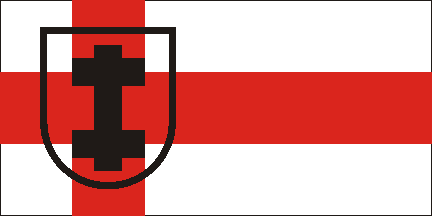 image
by Juan Manuel Gabino Villascán, 23 March 2006
image
by Juan Manuel Gabino Villascán, 23 March 2006
 image
by Juan Manuel Gabino Villascán, 23 March 2006
image
by Juan Manuel Gabino Villascán, 23 March 2006
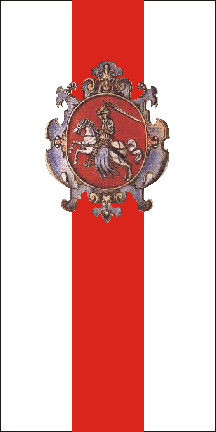 image
by Juan Manuel Gabino Villascán, 23 March 2006
image
by Juan Manuel Gabino Villascán, 23 March 2006
Dear friends,
As you surely know, presidential elections held in Belarus last week
resulted to be undemocratic and unfair, according the people domonstrating
at Minsk main square and other cities.
Demonstrators are seen to be flying the former Belarusian tri-band w-r-w
flag, while others are flying Georgian (the new one of course), Ukranian and
Polish national flags, in addition of the EU's.
Here you are three gifs of flags I have seen in many photos from the web,
yahoo!news, cbc new, bbc news, and others.
Those flags are interesting in my particular point of view, since they are
all but tri-band, instead, the first image bears a transparent
black-outlined shield charged by a black double-beamed cross -Lorraine
cross- (surely that shield featured in the Pahonia -on the knight's
shoulder-), the whole over the intersection of a "scandinavian" red cross on
a white field; and the second image is also white with the red
scandinavian cross, in the canton is the shield charged by the cross.
A third flag is the triband only charged withe the whole
Pahonia (emblem in gif image taken from
http://www.belarusguide.com/as/history/pahonia.html ).
Juan Manuel Gabino Villascán, 23 March 2006
 image
by Klaus-Michael Schneider, 16 May 2006
image
by Klaus-Michael Schneider, 16 May 2006
It is a white over red over white horizontal tricolour of unknown
ratio. In the centre of the flag is a red-edged white lorraine cross
with two equal horizontal crossbars. In the centre of the cross is
another one of red color. The flag is probably a variant of the flag
of the Belarus Popular-Front It was waved in a rally against
President Lukashenko's victory of the last elections in Minsk. Source: Morgenmagazin, 20th March 2006, news on ARD(1st German TV)
Klaus-Michael Schneider, 16 May 2006.
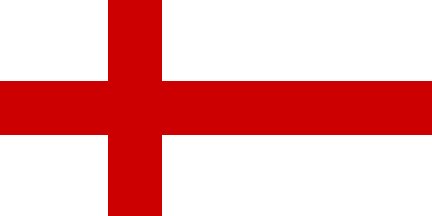 image
by António Martins-Tuválkin, 24 March 2018
image
by António Martins-Tuválkin, 24 March 2018
White flag with red cross is an official flag of Belarusian
Christian-Democratic Union (adopted 1991) and Unity of Belarusian
Students (swallow-tailed flag, officially adopted in 1992)
Victor Lomantsov, 16 May 2000
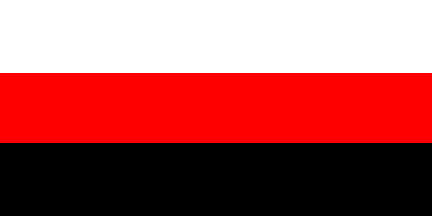 image
by Zachary Harden, 9 Febuary 2003
image
by Zachary Harden, 9 Febuary 2003
Flags from Belarus in German TV news (ARD and ZDF) - One flag
was a new one, I didn't see it before. A tricolore with vertical
white-red-black-stripes. Do anybody know this flag and its
meaning ?
J. Patrick Fischer, 10 September 2001
The Belarusian Resistance must be very similar than Belarusian
Nationalist Mouvement, or even part of it. The official flag used
by Belarusian Resistance is exactly like the Belorussian
Nationalist Mouvement one , but, according to Belarusian
Resistance's website (<www.rubon.org>)
they are using other flags too like the tricolor one plain
horizontal white,red and black stripes.
Santiago Tazon, 23 January 2003
In Belarus, the tricolor with horizontal white-red-black
stripes is a flag of Belarusian ultra-conservative illegal party
called "Belarusian Freedom Party". As explained by a
member of this political party: "This is the traditional
white-red-white flag of Belarus with the black stripe which
symbolize the people who were killed during the soviet occupation
of the country, and it will be changed for the white stripe only
when Belarus will be really liberated from the Soviet
past",
I. Shuk, 3 Febuary 2003
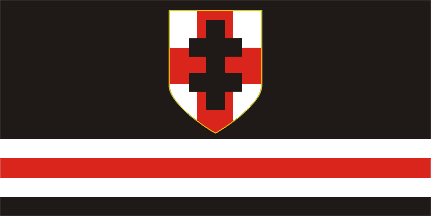 image
by Victor Lomantsov, 26 December 2002
image
by Victor Lomantsov, 26 December 2002
Flag of Belorussian Nationalist Movement can be seen at <members.odinsrage.com/rubon>.
Jens Pattke, 25 December 2002
The flag of nationalistic "Young Front" (youth
section of Belorussian People`s Front, BNF) was adopted 12, Nov,
1997 (1 year after 1st Congress of YF and foundation Council of
the Front, 12.11.1996)
Victor Lomantsov, 26 December 2002
Taking a look at the Belarus Nationalist flag, it's worth
noting that the double-armed cross at the center of the device
was also used as a collar tab for Waffen-SS personnel of the
Waffen Grenadier Division des SS (russiche Nr. 2), which
apparently was made up largely of Belarusian recruits.
John Evosevic, 28 December 2002
I can't speak or read Russian/Belarusian (apart from
transliterating the letters), but the English page looks very
racist. See: <members.odinsrage.com/rubonl>
for their "key concepts of nationalism". I guess
"nationalism" is the new code word for
"racism".
Dean McGee, 28 December 2002
John Evosevic report is not correct. The symbol
itself -- six-ended white/silver cross, usually on red shield --
is known from medieval era. In Belarusian culture it is named
"Cross of Yaryla". "Yaryla" was the name of
solar deity in ancient Slavs panteon, the cross itself is
considered to be transformed solar symbol. This cross was wielded
by a horseman on coat of arms of medieval state comprising modern
Lithuania, Belarus and Ukraine (Grand Duchy of Lithuania,
Ruthenia and "Zhamoyciya").
The coat of arms itself is named "Pagonia" (Vytis in
Lithuanian) and both cross and coat of arms are part of common
cultural heritage of Lithuania and
Belarus.
The white/silver outline of this cross (placed horizontally,
too) on black (?) background was indeed unit symbol of volunteer
unit "30.Waffen-Grenadier-Division der SS (russische
Nr.2)/30.Waffen-Grenadier-Division der SS (weissruthenische
Nr.1)" formed in 1944.
Yury Tarasievich, 5 July 2004
This is also quite similar to the Cross of Loraine, prominent
in the flag of the World War II French Resistance, and of course,
the Slavic Cross, which has featured in several flags of Eastern
Europe. A similar cross is prominent in Greek Orthodox usage as
well as Russian Orthodox, although it does not appear on the
current flag of Greece.
The symbolism is usually explained by saying that the second
cross-arm represents the sign "INRI" (Iesus Nazareni
Rex Iudorum, with apologies for my poor Latin spelling) over the
head of Christ, or the footrest, or both.
Is there a similar rationale for the Belarus/Lithuanian solar
cross? Is it Christian or pagan in origin?
Bill Dunning, 5 July 2004
The Cross of Yarla is of pagan origin, as explained in the
article. But as Lithuania and Belarus were Christianized, the
Cross of Yarla was also made acceptable as a Christian symbol, or
probably, a national symbol.
The Cross of Yarla's two crossbeams are of equal length. And the
length of the vertical beam is made of five quantities to the
crossbeams' three.
The Cross of Lorraine is a Latin cross, with an additional upper
crossbar. This two-armed or two-barred cross (sometimes both bars
are of equal length) is called a patriarchal cross in the Latin
Church and is a symbol of rank for the bishop carrying it.
Archbishops were entitled to use this cross. And the cities in
which Archbishops usually presided were often given the right to
use that cross in various places.
The Cross of Lorraine is part of the arms of Hungary and
Slovakia, due to historical ties with royal families. Sometimes
the two horizontal bars of the Cross of Lorraine are of equal
length, other times, the upper bar is shorter than the lower bar.
The Slavic, or Orthodox or Russian Cross is of three bars, the
top being shorter than the middle and the bottom bar being
slanted with the left side higher than the right (as you look at
it). The top bar was for the sign board, the center was for the
arms and the bottom was a footrest, contorted when Christ was
stabbed with the spear. The upper two bars are above the center
of the cross so that there is a greater distance between the
lower bar and the middle bar, compared to the distance between
the upper bar and the middle bar.
Ukrainians use the three bars but all are horizontal, and in some
instances, the top bar goes to the top of the Latin Cross, with
nothing of the vertical bar protruding from the top. Some Roman
Catholics of the Eastern Rite use the three-barred cross, and the
upper and lower bars are a bit longer than the Russian or
Ukrainian crosses, and are equidistant from the middle bar.
Fr John Udics, 5 July 2004
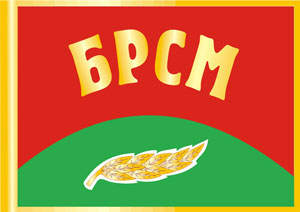 image
by Zachary Harden, 23 August 2019
image
by Zachary Harden, 23 August 2019
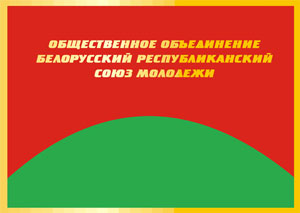 image
by Zachary Harden, 23 August 2019
image
by Zachary Harden, 23 August 2019
.jpg) image
from <brsm.by>,
located by Zachary Harden, 30 July 2005
image
from <brsm.by>,
located by Zachary Harden, 30 July 2005
Emblem
From <www.president.gov.by>:
"...following the merge of the Belarusian Patriotic Youth
Union and the Belarusian Youth Union (the legal successor of the
Belarusian Komsomol), a powerful youth organization was created -
the Belarusian National Youth Union (BRSM)."
Dov Gutterman, 31 July 2005
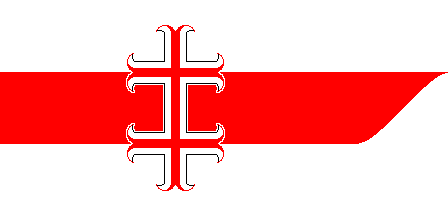 image
by Antonio Martins and Jorge Candeias, 7 July
1997
image
by Antonio Martins and Jorge Candeias, 7 July
1997
From <pages.prodigy.com/belarus>
:
"Belarusian Popular Front (BPF) is a broad political
movement of the newly independent Republic of Belarus, a former
republic of the Soviet Union. The organizational committee of the
BPF was established in October 1988 by intellectuals such as
Vasil Bykau, Mikhas Dubyanyetski, Zyanon Paznyak and others. The
governing organization, the Soim, was formed during the Front's
first congress in June 1989. At the same time, the organization's
charter was adopted which specified BPF's dual objective: the
attainment of democracy and independence through national rebirth
and rebirth of civil society, which was destroyed by communism
and foreign occupation. Zyanon Paznyak was elected Chair of the
Soim. He is a well known historian and archeologist who defended
the Belarusian culture and language in the years of communist
tyranny. Among his accomplishments are the excavations in the
forest region of Kurapaty on the outskirts of Mensk (Minsk) where
communists had killed more than 250,000 people from 1925 to
1941"
Party flag and emblems can be seen also at the same page.
Dov Gutterman, 6 March 1999
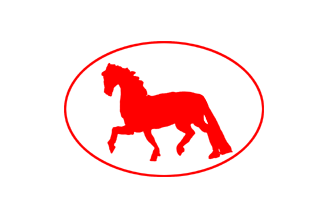 image
by Victor Lomantsov, 4 February 2004
image
by Victor Lomantsov, 4 February 2004
UCP flag is red logo (horse in oval) on white as seen at <ucpb.info>
and other photos in the site. United Civil Party (UCP) is a
leading liberal conservative party in the Republic of Belarus. It
was established on October 1, 1995 as a result of merger of two
like-minded parties - United Democratic Party (formed in 1990)
and Civil Party (formed in 1994). We stand for an independent
sovereign Belarus that pursues domestic and foreign policy
according to its national interests.
Dov Gutterman, 28 April 2003
The flag of United Civil Party was published in Flag Report 6
reported by A. Basov, from the register of Belarus where the
party and flag was registered on 14 August 1996.
Jaume Olle', 30 April 2003
Flag of United Civil Party (Ob``edinennaja grazhdanskaja
partija) is according to drawing of A. Basov (Minsk, Belarus).
Victor Lomantsov, 4 February 2004
Civil Forum
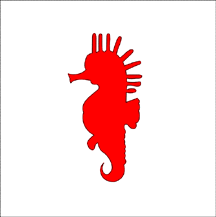 image
by Jaume Olle', 30 April 2003
image
by Jaume Olle', 30 April 2003
There is also a youth branch called Civil Forum that adopted
its flag on 14 May 1997.
Jaume Olle', 30 April 2003
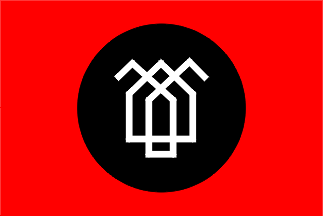 image
by Victor Lomantsov, 26 October 2003
image
by Victor Lomantsov, 26 October 2003
Flag of "White Legion" movement.
Source: letter of A.Basov from Minsk (Belarus).
Victor Lomantsov, 26 October 2003
Flags
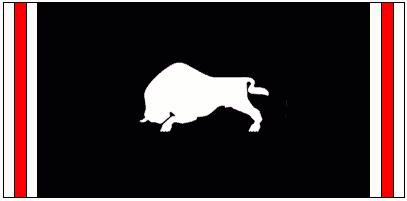 image
by J. Patrick Fischer, 10 September 2001
image
by J. Patrick Fischer, 10 September 2001
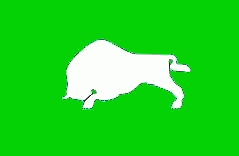 image
by J. Patrick Fischer, 23 March 2006
image
by J. Patrick Fischer, 23 March 2006
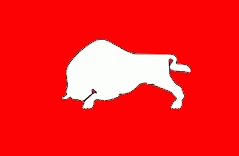 image
by J. Patrick Fischer, 23 March 2006
image
by J. Patrick Fischer, 23 March 2006
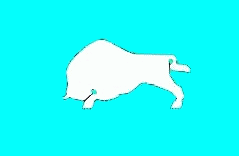 image
by J. Patrick Fischer, 23 March 2006
image
by J. Patrick Fischer, 23 March 2006
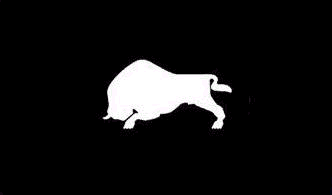 image
by J. Patrick Fischer, 10 September 2001
image
by J. Patrick Fischer, 10 September 2001
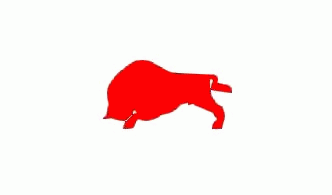 image
by J. Patrick Fischer, 23 March 2006
image
by J. Patrick Fischer, 23 March 2006
Emblem
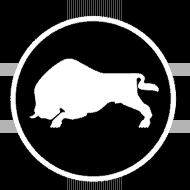 image
from <www.zubr-belarus.com>,
located by J. Patrick Fischer, 10 September 2001
image
from <www.zubr-belarus.com>,
located by J. Patrick Fischer, 10 September 2001
In reports of German TV ZDF, I could see different flags of
the political opposition group "Bison" (a European
buffalo, living in Belarus and Poland) in Minsk/Belarus. One was
hanging in one of the HQ at the wall. It was black with a side
view silhouette of a white Bison in the center. At the right and
the left side were thin vertical white-red-white stripes. Other
flags were shown at a demonstration, yesterday in Minsk. Again
the white Bison, but on different coloured backgrounds. I saw
red, light blue and green variations, all without the
white-red-white-stripes. I found the homepage of the Bisons
(Zubr): <www.zubr-belarus.com>.
J. Patrick Fischer, 10 September 2001
Again new flags in German TV news (ARD and ZDF) from Belarus.
I saw the Bison flag with red Bison on white background and white
Bison on black background, without stripes on the side. I checked
the propotions now. The Bison-flags seem to have 2:3.
J. Patrick Fischer, 10 September 2001
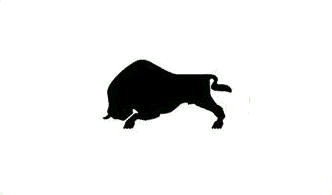 image
by J. Patrick Fischer, 19 October 2004
image
by J. Patrick Fischer, 19 October 2004
Yesterday was a report of the Belarus election in German TV
ZDF. After the publication of the results was a short-living
demonstration against president Lukaschenka (Lukashenko). Again,
there was a flag of ZUBR, the opposition group. Again a little
variation. A black bison on a white field. I saw some blue flags,
too, but I couldn't see any details.
J. Patrick Fischer, 19 October 2004
I saw this or similar footage on "The World" on BBC4
tv on 19 October. The former white-red-white triband was also
used.
André Coutanche, 27 October 2004
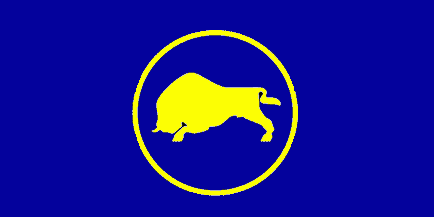 image
by J. Patrick Fischer, 23 March 2006
image
by J. Patrick Fischer, 23 March 2006
On the new demonstrations taken place in the moment in Minsk was a new
ZUBR-flag to see: by}zubr8.gif
Maybe it was inspiried by the EU-flag. A yellow bison in a yellow circle on
European blue. Size 1:2.
J. Patrick Fischer, 23 March 2006
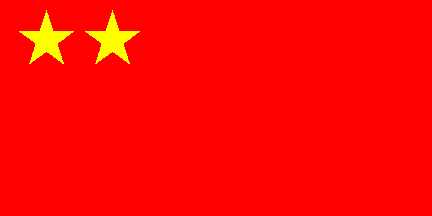 image
by Zach Harden, 3 November 2001
image
by Zach Harden, 3 November 2001
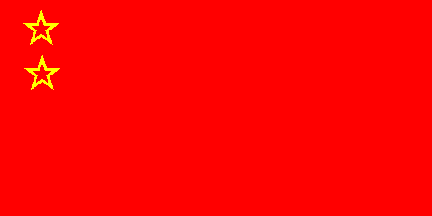 image
by Zach Harden, 3 November 2001
image
by Zach Harden, 3 November 2001
Since 1995, an union of Russia and Belarus (sometimes
including other Slavic and/or ex-Soviet countries) has been
repeatedly proposed by Belarusian president Lukashenka, and was
received with moderate enthusiasm by the Russian presidency and
by the successive cabinets. The vexillological implications of
the projected union remain unknown.
Antonio Martins , 29 October 1999
Two flags reported to be used/proposed by the RU-BY
Union. The flag drawings were made by me, but the images
were made from Victor Lomantsov's website. Both flags have
a red background, two yellow/gold stars (showing the union), and
both are 1:2 ratio. The ideas came from the Soviet flag,
and which both countries used to belong to from the start.
The only difference is the type of stars used, and the placement
of them. The first one is where the stars are side-by-side,
and are colored in full. The second one is where one star
is above the other, and the Soviet star design was used.
Zach Harden, 3 November 2001
From their "constitution":
"Article 1 - The Community of Russia and Belarus shall be
transformed into a Union with the terms of reference stemming
from its Charter.
Each of the member countries of the Union shall retain its state
sovereignty, independence, territorial integrity, Constitution,
national flag, coat of arms and other accoutrements of
statehood."
Even though the central government will have flags to represent
the Union, each country belonging to the union can keep their
current symbols, which most are USSR related (Belarus flag, coat of arms,
anthem; Russian anthem). The Russian/Soviet anthem will be
used for the Union anthem, and no coat of arms is in the works as of this
time. At the first meeting of the Union Council, Alexander
Lukashenko sang the anthem, everyone joined in, and selected the
tune of the USSR/Russia anthem. New words will be set in
place soon.
Zach Harden, 26 November 2001
 image located by Edward Reilly, 25 January 2011
image located by Edward Reilly, 25 January 2011
This Opposition Party flag = former Belarus / Gudija flag (white / red /
white) with Baltic 8-point star is found at
http://www.youtube.com/watch?v=qdroiJJhGzA&feature=related @ 0:43
minutes. Another image can be found at
http://www.opendemocracy.net/od-russia/david-marples-uladzimir-padhol/belarus-most-peculiar-election.
Edward Reilly, 25 January 2011
See also
http://www.demotix.com/photo/438051/vital-rymashevsky-comes-presidential-election-belarus
and more information about the
party at
http://en.wikipedia.org/wiki/Belarusian_Christian_Democracy.
Jens
Pattke, 19 February 2011
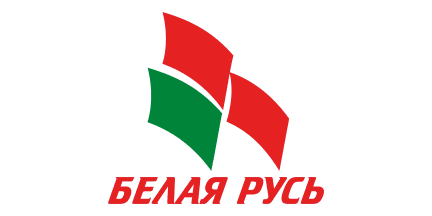 image by Zachary Harden, 24 August 2020
image by Zachary Harden, 24 August 2020
The flag of the organization "Belaya Rus" can be seen at
http://www.belayarus.by/sm.aspx?guid=11306. The basic design is of the logo
on a white background with a ratio of 1x2. The logo of the group is at
http://beta.inosmi.ru/images/16786/32/167863279.jpg. A short entry about
this group is mentioned on Wikipedia: "Belaya Rus is a Belarusian public
association not registered as a political party officially, founded on 17
November 2007 to support President of Belarus Alexander Lukashenko, based on the
idea of Vladimir Putin's United Russia party."
Wikipedia
Zachary Harden, 14 July 2011
According to this source, the flag has a ratio of 1x2 and the logo's length used is 1/2th of the length of the flag. As for the meaning of the symbol:
The logo symbolizes the unity of the head of state - the President of the Republic of Belarus, the Belarusian people and the government (three stylized sails) based on the solution of goals and objectives determined by the course of the head of state aimed at building a strong, independent and prosperous Belarus. White color of the field - the color of purity symbolizes the activities of a public association based on the principles of legality, voluntariness, independence and publicity. In general, the flag symbolizes the unification of the progressive forces of society, interested in building a strong and prosperous Belarus, a socially just society based on the patriotic, spiritual and moral values of the Belarusian people.
There are many variants of the flag, sometimes with the branch name or the designation "Республиканское общественное объединение" (Republican Public Association) above the logo in red.
Zachary Harden, 24 August 2020